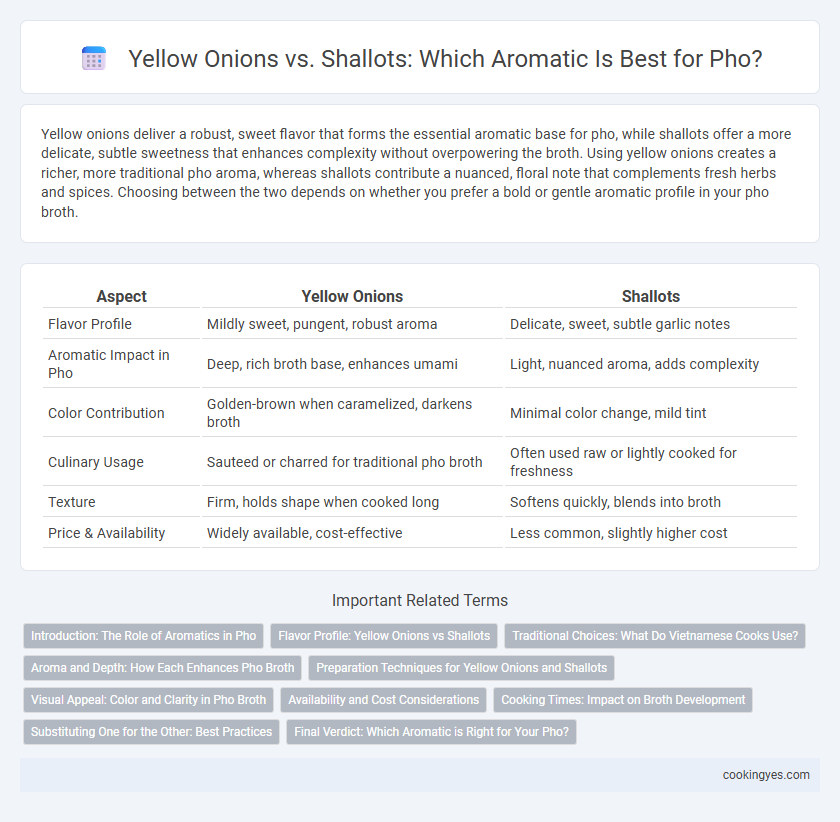Yellow onions deliver a robust, sweet flavor that forms the essential aromatic base for pho, while shallots offer a more delicate, subtle sweetness that enhances complexity without overpowering the broth. Using yellow onions creates a richer, more traditional pho aroma, whereas shallots contribute a nuanced, floral note that complements fresh herbs and spices. Choosing between the two depends on whether you prefer a bold or gentle aromatic profile in your pho broth.
Table of Comparison
| Aspect | Yellow Onions | Shallots |
|---|---|---|
| Flavor Profile | Mildly sweet, pungent, robust aroma | Delicate, sweet, subtle garlic notes |
| Aromatic Impact in Pho | Deep, rich broth base, enhances umami | Light, nuanced aroma, adds complexity |
| Color Contribution | Golden-brown when caramelized, darkens broth | Minimal color change, mild tint |
| Culinary Usage | Sauteed or charred for traditional pho broth | Often used raw or lightly cooked for freshness |
| Texture | Firm, holds shape when cooked long | Softens quickly, blends into broth |
| Price & Availability | Widely available, cost-effective | Less common, slightly higher cost |
Introduction: The Role of Aromatics in Pho
Aromatic ingredients like yellow onions and shallots are crucial for creating the rich, complex flavor profile characteristic of authentic pho broths. Yellow onions provide a deep sweetness and caramelized undertones when charred, enhancing the broth's savory depth. Shallots contribute a milder, subtly sweet aroma that complements other spices, offering a delicate balance to the pho's signature fragrance.
Flavor Profile: Yellow Onions vs Shallots
Yellow onions provide a robust, slightly sweet, and pungent flavor that deepens the savory broth of pho, contributing to its rich and caramelized aroma. Shallots offer a milder, more delicate sweetness with subtle garlic undertones, enhancing the broth with a nuanced, refined fragrance without overpowering other ingredients. The choice between yellow onions and shallots significantly influences the depth and balance of the pho's aromatic profile, shaping the overall taste experience.
Traditional Choices: What Do Vietnamese Cooks Use?
Vietnamese cooks traditionally prefer yellow onions over shallots for pho aromatics due to their robust sweetness and caramelization properties that enhance broth depth. Yellow onions impart a richer, earthier flavor that balances the umami from beef bones, making them a staple in authentic pho recipes. Shallots, while milder and more delicate, are less commonly used because they do not provide the same intensity crucial for the signature pho broth.
Aroma and Depth: How Each Enhances Pho Broth
Yellow onions contribute a robust, slightly sweet aroma and deepen the broth with rich caramelized notes that enhance pho's savory profile. Shallots offer a subtler, more delicate fragrance with floral undertones, adding complexity without overpowering the broth's lightness. Combining yellow onions and shallots creates a balanced aromatic foundation that intensifies pho's depth and enhances its traditional flavor nuances.
Preparation Techniques for Yellow Onions and Shallots
Yellow onions and shallots enhance pho's aromatic profile through distinct preparation techniques. Yellow onions are typically charred or caramelized to develop deep, sweet flavors and a rich color, while shallots are often lightly toasted or sauteed to preserve their delicate, mildly sweet notes. Both methods maximize the release of essential oils and complement the broth's layered taste.
Visual Appeal: Color and Clarity in Pho Broth
Yellow onions impart a rich amber hue to pho broth, enhancing its visual warmth and depth, while shallots contribute a subtler, clearer appearance with a light golden tint. The caramelization of yellow onions intensifies the broth's color, creating an inviting and robust aesthetic. Shallots, being milder, maintain broth clarity and a cleaner presentation, ideal for a delicate and refined pho experience.
Availability and Cost Considerations
Yellow onions are widely available and generally more affordable than shallots, making them a cost-effective choice for pho aromatics in most grocery stores and markets. Shallots, while providing a milder and slightly sweeter flavor, tend to be pricier and less common, which can limit accessibility for home cooks and restaurants on a budget. Opting for yellow onions ensures consistent supply and budget-friendly pricing without compromising the essential aromatic foundation of pho broth.
Cooking Times: Impact on Broth Development
Yellow onions release sugars and develop a rich, caramelized flavor during longer cooking times, enhancing pho broth with deep, savory notes. Shallots cook faster and impart a subtler, sweeter aroma, resulting in a lighter, more delicate broth profile. Choosing yellow onions supports a robust broth development, while shallots are ideal for quick-simmered pho with nuanced aromatic complexity.
Substituting One for the Other: Best Practices
Yellow onions and shallots both contribute rich, aromatic flavors to pho, but substituting one for the other requires mindful adjustments due to their distinct taste profiles. Yellow onions offer a robust, slightly sweet flavor with higher sulfur content that intensifies the broth, while shallots provide a milder, more subtle sweetness and delicate aroma perfect for lighter pho variations. When substituting, reduce the quantity of yellow onions by half to mimic shallots' gentle flavor, or increase shallots slightly to achieve the depth of yellow onions without overpowering the broth.
Final Verdict: Which Aromatic is Right for Your Pho?
Yellow onions offer a robust, slightly sweet flavor that deepens the pho broth with rich umami notes, making them ideal for traditional recipes. Shallots provide a milder, more delicate sweetness and subtle garlic undertones, enhancing the broth's complexity without overpowering other spices. Choosing between yellow onions and shallots depends on whether you prefer a stronger, earthier base or a nuanced, refined aroma in your pho broth.
Yellow onions vs shallots for pho aromatics Infographic

 cookingyes.com
cookingyes.com